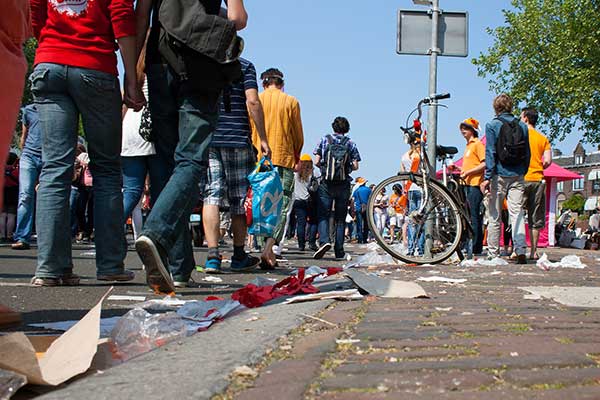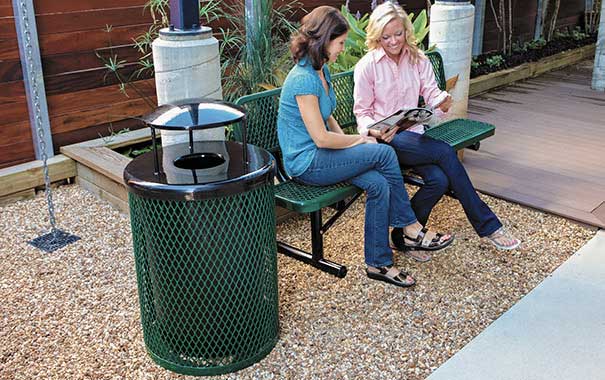 Summer time means more events and unfortunately, more trash. In this day of excessive garbage, adding more commercial trash cans at key locations is one solution
Summer time means more events and unfortunately, more trash. In this day of excessive garbage, adding more commercial trash cans at key locations is one solution
It's "Summertime and the livin'" is easy…and unfortunately, the commercial trash cans will be overflowing.
Summer is a fantastic season for a number of reasons. But as more people spend more time outdoors at parks, concerts, restaurants, theme parks and other facilities, that also means there will be a greater accumulation of garbage.
Let's face it. Litter is not a pleasant subject. But when you look at the ugly statistics, it's definitely something every park and facility manager should be concerned about.
1. The average American produces 4.4 pounds of trash, EVERY DAY, according to the Environmental Protection Agency.
2. That amounts to about 700,000 tons of garbage, EVERY DAY.
3. In a survey of Americans conducted by Keep America Beautiful, 43% of respondents said they had littered in the past 30 days.
4. Young people tend to litter more than older people.
5. Males litter more than females.
6. The top sources of trash in order: cigarette butts, paper, food wrappers and discarded food.
7. The three top states that produced the most trash per person: Colorado, Pennsylvania, and Nevada.
8. The three best states for least amount of garbage per person: Idaho, North Dakota and Connecticut.
9. America has increased its recycling rate substantially in the past 30 years from 6.2% to 34%, but is still behind Germany, Austria, Taiwan, South Korea, the United Kingdom and Italy when it comes to the percentage of recycled trash.
10. Talk about global warming. Sure, everybody wants to blame cars and smokestacks. But consider the effect of garbage. Mainly, methane gas that is produced by trash.
According to the EPA, methane creates 21 times as much warming as the same amount of CO2 over a long period of time.
In fact, methane is 84 times more potent when it comes to greenhouse gases.
That's the bad news.
The good news is that we are getting better at collecting and recycling trash.
When it comes to our environment, trash is a bummer. It's an eyesore, it's unhealthy and it's one of the reasons many cities now face a problem with rodents.
What Walt Disney learned about the placement of commercial trash cans
 Commercial trash can placed strategically next to a park bench
Commercial trash can placed strategically next to a park bench
There are several proven strategies to follow that can reduce the amount of litter in an area, whether it's a park, outside a restaurant or near a mall.
- Check the availability of trash receptacles. Heavy-duty commercial trash cans should be available throughout a facility. In today's "biggie size" food environment, people are toting around sizable amounts of trash from packaging in their hands. Big Gulps and the wrappers for Big Macs and Baconator's all need to land somewhere.
- Do you want to know why Disneyland and DisneyWorld always seem so clean? When he wasn't drawing or directing, Walt Disney spent a considerable amount of time observing the litter habits of visitors to his parks. He determined that commercial trash cans should be available every 25-30 paces to ensure people have the opportunity to discard their trash properly. Each facility is different. Be like Walt and spend time observing the trash habits of your visitors. (Note: The Park and Facilities Catalog has supplied trash receptacles to Disney parks).
- When observing litter bugs, researchers with Keep America Beautiful observed that one frustrating aspect of trash is that litter creates more litter. If people see litter on the ground, many will see that as a green light for them to just dump their trash as well.
- Keep emptying those commercial trash cans. Many facilities will place trash receptacles at key points, but one receptacle might not be enough. Overflowing trash cans create another green light for people to dump their trash either on top of the heap, where it will eventually fall to the ground. Or they will just toss their garbage on the ground, figuring there is no place to dispose of it properly.
- KAB reported: "The availability and distance of trash receptacles were strongly predictive of littering behavior."
- Encourage visitors and customers to dispose of litter properly with signage or on-package messages. Remember the public ad campaign against litter with the crying Native American standing by the roadside? It was extremely effective. Put up clever signs to remind people not to litter. Perhaps engage school kids to come up with some posters to promote the right way to dispose of trash. Another tactic, remind people of the fines that they might incur for littering. Arrange for the police to cite a few people here and there. Word will spread.
- Add more outdoor ashtrays. As KAB researchers found, discarded cigarette butts are the No. 1 source of trash. These items might be small, but they accumulate quickly and create an unpleasant site.
- Watch social sites. In this day and age, people will vent their frustration on sites like Yelp and Google. If they complain about litter at your park, facility or establishment, respond quickly on the social site and quickly at your location.
On an individual basis, here are a few things you can do:
- Use reusable containers.
- Avoid items that are individually wrapped, which is wasteful.
- Buy items like soap, in concentrated liquid form rather than individual bars of soap.
- Surprisingly, food waste is an enormous form of garbage. Instead of sending these valuable organic remnants to the landfill, put them in compost bin and recycle.
- Buy in bulk.
- Try to cut down on the direct mail you receive that you don't care about.
- Buy recycled paper and products such as recycled plastic benches and picnic tables. This completes the super-critical loop of Collection, Re-Manufacturing and the Purchase/Re-Use of plastic and paper scrap.
We are making progress. While every American generates quite a bit of garbage, according to the EPA, the recycling rate in the US is at an all-time high.
This summer - be prepared to reduce unsightly litter and direct more of it to the recycling bins.
As you add more commercial trash cans in key locations, also consider adding more recycling receptacles as well. Make this summer a litter-free season at your park or facility. That can be just as enjoyable as a concert or event in the park.


